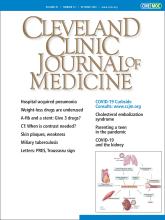Article Figures & Data
Tables
- TABLE 1
Anticoagulation after percutaneous coronary intervention in patients with atrial fibrillation
Time after PCI Low risk of stroke, low risk of bleedinga High risk of stroke, low risk of bleeding Low risk of stroke, high risk of bleeding 0–1 month DOAC plus P2Y12 inhibitor DOAC plus P2Y12 inhibitor plus aspirin DOAC plus P2Y12 inhibitor 1–6 months DOAC plus P2Y12 inhibitor DOAC plus P2Y12 inhibitor DOAC plus P2Y12 inhibitor 6–12 months DOAC plus P2Y12 inhibitor DOAC plus P2Y12 inhibitor DOAC only After 12 months DOAC only, discuss risks and benefits DOAC only, discuss risks and benefits DOAC only, discuss risks and benefits ↵a For example, with CHA2DS2-VASc score of 0 or 1 and HAS-BLED score of 0–2.
DOAC = direct-acting oral anticoagulant; PCI = percutaneous coronary intervention






